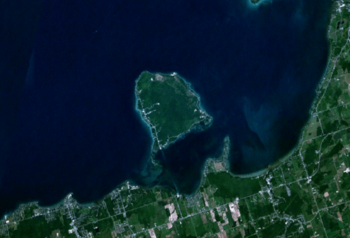Georgina Island facts for kids
|
Native name:
Waaseyaagmiing
|
|
|---|---|

A satellite image of Georgina Island in the southeast part of Lake Simcoe
|
|
| Geography | |
| Location | Lake Simcoe |
| Administration | |
|
CAN
|
|
| Province | Ontario |
| Region | York |
| Municipality | Georgina |
Georgina Island (Ojibwe: Waaseyaagmiing) is the biggest island in Lake Simcoe, located in southern Ontario, Canada. It is a First Nation community where the Chippewas of Georgina Island First Nation live. These are Ojibwa people. The island is also part of the Town of Georgina and the Regional Municipality of York.
Long ago, before the Trent–Severn Waterway was finished, the water in Lake Simcoe was much lower. People could even walk or drive wagons across to the mainland at Virginia Beach. But after the waterway was built, the water level rose. This covered old farmlands and made it necessary to use a boat to cross to the mainland.
In 2002, Pope John Paul II stayed on nearby Strawberry Island for four days. This was just before a big event called World Youth Day 2002 in Toronto.
You can reach Georgina Island by a ferry in the summer. In winter, when the lake freezes, an airboat helps people cross. On the coldest days, the ice gets thick enough for an ice road. This allows light vehicles to drive safely across the frozen lake. The Women's Support Network of York Region has also worked with the First Nations community on Georgina Island.
Contents
History of Georgina Island Settlement
During the American War of Independence, British leaders wanted to make friends with the Native people in what is now Ontario. They wanted to gain control of their lands to protect British North America. The Chippewas of Lakes Huron and Simcoe were several groups of people in the early 1800s.
Early Land Agreements
Two groups, led by William Yellowhead and Joseph Snake, lived in southern Simcoe County. They gave up their lands to the government in 1818. Another group, led by John Aisance, lived between Kempenfelt Bay and Penetanguishene. They also gave up their lands in 1815.
In 1830, the government set aside Georgina Island, Snake Island, and Fox Island in Lake Simcoe as special lands for these groups. These lands were called a reserve. However, the government encouraged the people to move to new villages built for them. These villages were at Coldwater (where Aisance's group settled) and Atherley Narrows (where Yellowhead and Snake's groups settled). The idea was for them to start farming there.
Changes to Traditional Lands
There was also a strip of land between Lake Couchiching and the Severn River. This land was informally given to the Chippewas for hunting. But in 1836, a new agreement was made. This land, including the two villages, was returned to the government. This meant the Lake Simcoe islands became the last reserve for the Chippewas.
Yellowhead and his group bought land at Rama and moved there in 1838. Aisance led his people to Beausoleil Island in Georgian Bay in 1842. They later moved again to Christian Island in 1856. As these groups moved, some people stayed behind on Snake Island and nearby islands with Snake as their leader.
Government's Role and Impact
The government's actions greatly affected the First Nations people. They had a policy to make the people rely on the Crown. This policy included promises of protection, food, clothing, and general support. This changed the communities from being independent to depending more on the Crown.
The area between Lake Ontario, Georgian Bay, and Lake Simcoe was very important for defending Upper Canada. This region was home not only to the Lake Simcoe Indigenous People but also to the Six Nations people, led by Joseph Brant. The Six Nations community is located in the town of Ohsweken, Ontario.



